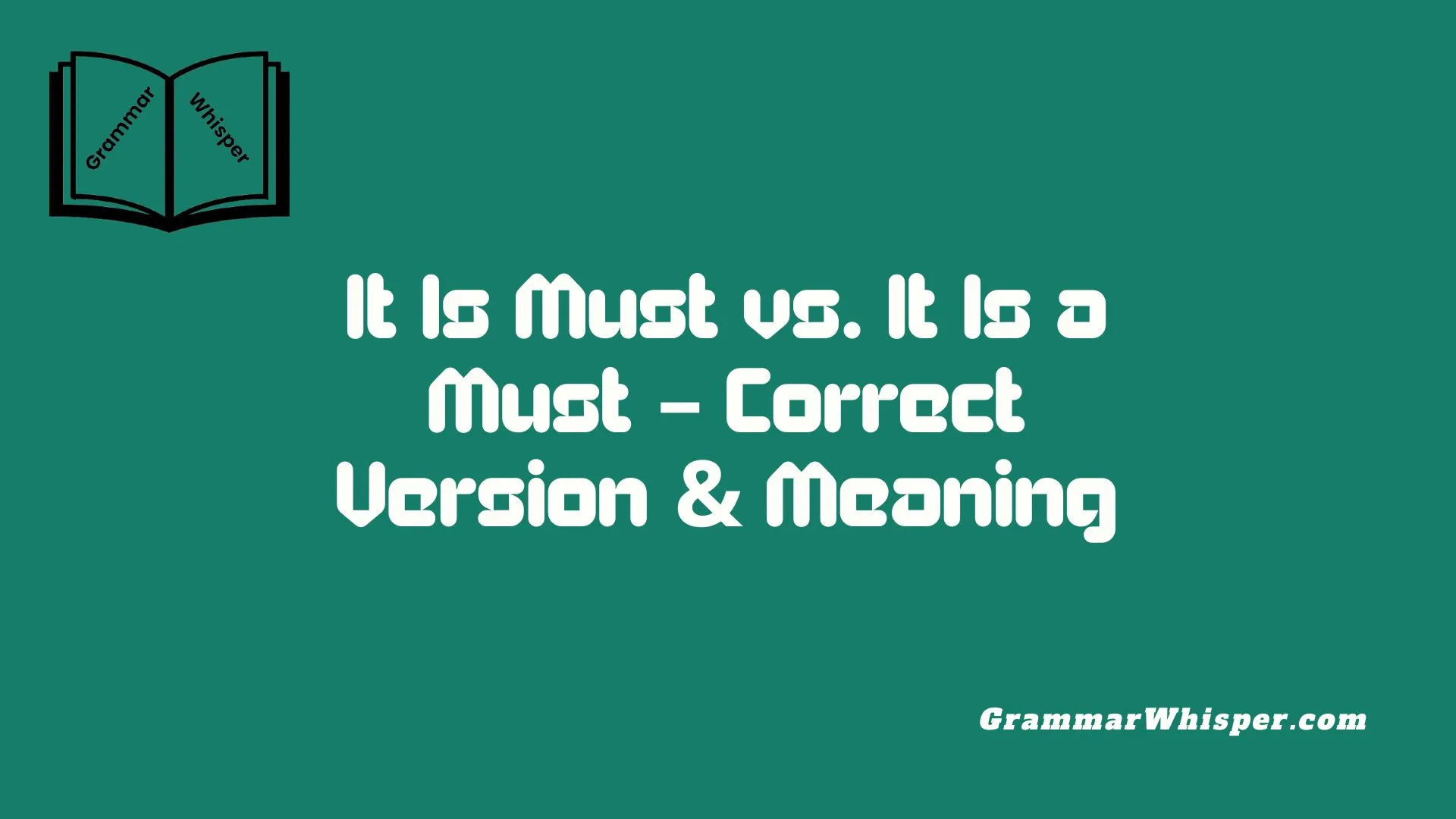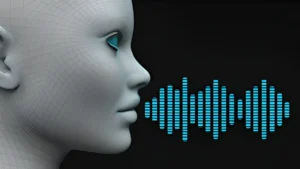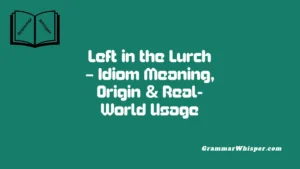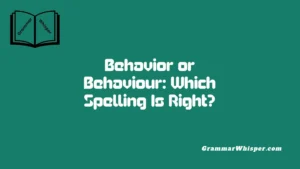You might have come across the phrase “It is must” while reading emails, scrolling social media, or skimming product reviews. Some people used it interchangeably with “It is a must”, but there’s a clear difference. One only sounds right – the other holds up to grammatical scrutiny. The confusion stems from how the word must functions in English. It can be a modal verb (“You must go”) or a noun (“That trip is a must”). And when it acts as a noun, it needs an article. That’s why only “It is a must” is grammatically correct. This small version change actually plays a big role in making your message strong.
I had to clarify this recently while curating website content for a brand. They had written “It is must-have” in a blog post, but it didn’t feel credible. I explained that language, while often quirky, still follows core rules – especially in formal and professional writing. A single important and subtle distinction can elevate your expression. That moment became a quick guide for them, one that unpacks the grammar behind both phrases. With real usage and clear examples, you can easily explore the tools and tips to remember the right structure. Once you get it, your writing will improve naturally. And in clear communication, using what’s accepted over what’s mistaken is absolutely a must.
Hooking Introduction: Why This Phrase Causes So Much Confusion
You’ve probably come across both “It is must” and “It is a must” on social media, in emails, or even in product reviews. Maybe you’ve used both interchangeably. But there’s a big difference. Only one stands up to grammatical scrutiny.
The confusion stems from how “must” functions in English. It can be both a modal verb and a noun. And when it’s used as a noun, it needs an article – hence, “a must.”
Let’s explore the grammar behind it, how it’s used in real life, and why getting it right makes your message more professional and credible.
Dissecting the Core: What Does “Must” Really Mean?
The word “must” has two primary grammatical identities:
- As a modal verb, it expresses necessity, obligation, or certainty.
- As a noun, it refers to something that is essential or very important.
Understanding these roles is key to using the phrase correctly.
Modal Verb Examples:
- You must complete the form.
- She must be tired after the trip.
Noun Examples:
- This book is a must for all entrepreneurs.
- Visiting Rome is a must when in Italy.
When using “must” as a noun, it behaves like any other countable noun – which means it needs an article like “a.”
The Role of ‘Must’ as a Modal Verb
As a modal verb, “must” is always followed by the base form of a verb and never stands alone.
Structure:
Subject + must + base verb
Examples:
- I must go now.
- You must see this documentary.
In this form, “must” adds urgency, obligation, or strong recommendation. It never appears with an article because it’s not functioning as a noun.
Incorrect: It is must.
Why? Because “must” as a verb cannot be the complement of “is” without an action following it.
Understanding ‘Must’ as a Noun: When It Refers to Necessity
In its noun form, “must” refers to an object or concept that is essential. This is the only case where the phrase “It is a must” is grammatically correct.
Correct Usage:
- A passport is a must for international travel.
- That movie is a must for thriller lovers.
Here, “must” acts like a thing you need or strongly recommend.
Real-Life Examples:
| Sentence | Function of “Must” | Grammatical Status |
| You must finish your homework. | Modal verb | Correct |
| This app is a must for designers. | Noun | Correct |
| It is must to follow the rules. | Incorrect use | Wrong |
| It is a must to follow the rules. | Noun | Correct |
The Phrase “It Is a Must”: Why It’s Grammatically Correct
Let’s break it down:
It = subject is = linking verb a must = noun phrase (with article + noun)
The phrase behaves just like:
- It is a rule.
- It is a necessity.
That’s why “It is a must” fits grammatically and logically.
Examples in Use:
- “A seatbelt? Oh, it’s a must!”
- “This training session is a must for all new hires.”
These are not just colloquial expressions; they’re grammatically sound, culturally appropriate, and semantically clear.
The Phrase “It Is Must”: Why It’s Incorrect and Misleading
The error in “It is must” comes from treating a verb or unmarked noun as a stand-alone noun phrase without proper structure.
Why It Sounds Off:
- Lacks an article
- Misuses modal verb without a main verb
- Not used by native speakers
Examples of Incorrect Usage:
- “It is must to attend.” ❌
- “That product is must for me.” ❌
Corrected:
- “It is a must to attend.”
- “That product is a must for me.”
Grammar Rule Reminder: When using countable nouns like “must” in a sentence, they require an article (“a” or “an”) unless they’re plural or used in a list.
Native Usage Insights: US vs UK English Patterns
Though both American and British English accept “It is a must,” there are some stylistic preferences.
British English:
- More likely to use formal structures
- May say “It is essential” instead
American English:
- More conversational
- Embraces phrases like “It is a must-have”
Summary Table:
| Phrase Style | UK Preference | US Preference |
| It is a must | Less frequent | Very common |
| It is essential | Common in writing | Used, but less casual |
Data Deep Dive: Google Ngram Viewer Comparison
To assess how often these phrases appear in published English, we used Google Ngram Viewer:
“It is a must” saw a steady rise from the 1980s onward, especially in lifestyle, travel, and tech books.
“It is must” barely registers on the graph, affirming its rarity and incorrectness in formal publications.
Frequency Snapshot (Books published 1950-2019):
| Phrase | Popularity Index |
| It is a must | 0.0000035 |
| It is must | 0.0000001 |
Professional Communication Matters: Why Tiny Errors Cost Big
Your language choices reflect your attention to detail. Small grammar mistakes like “It is must” may seem trivial, but they damage credibility.
In Business:
- Resumes with grammar errors get rejected.
- Emails with incorrect phrasing hurt trust.
In Education:
- Essays and research reports demand precision.
- Phrases like “It is must” flag as non-native or poorly edited.
Smarter Alternatives to “It Is a Must”
Want variety in your writing? Here are some alternatives:
Formal Synonyms:
- It is essential
- It is mandatory
- It is imperative
Casual Variants:
- You gotta try it
- It’s a no-brainer
- Don’t miss it
Rewriting Example:
| Original | Alternative |
| It is a must | It’s highly recommended |
| That is a must-read | It’s essential reading |
Synonyms & Contextual Phrasing: Sounding Fluent and Natural
Let’s take a deeper look at when to use different synonyms based on tone and audience:
| Use Case | Preferred Phrase |
| Job Interview Advice | It is imperative |
| Casual Blog Post | It’s a must-see |
| Academic Paper | It is essential |
| Product Review | A must-have |
Side-by-Side Usage Comparison: Right vs. Wrong
Here’s a quick-reference table for clarity:
| Incorrect Phrase | Correct Version | Explanation |
| It is must | It is a must | Needs article “a” |
| This is must | This is a must | “Must” used as noun |
| Is must be done | It must be done | Modal verb needs structure |
| Must-have item it is | It is a must-have item | Sentence needs reordering |
Case Studies: How Writers and Speakers Get This Wrong
Example 1: Social Media
Incorrect: “This product is must!” Correct: “This product is a must!”
Example 2: Online Review
Incorrect: “It is must to have insurance.” Correct: “It is a must to have insurance.”
Example 3: Email from a Candidate
Incorrect: “Working with your company is must for my career.” Correct: “Working with your company is a must for my career.”
Grammar Tip Sheet: Avoiding These Common Slip-Ups
- Always add “a” before “must” when using it as a noun.
- Don’t isolate “must” without context – add a verb or noun form.
- Read your sentence aloud. Does it sound natural?
Mnemonic:
If it’s a thing, it needs a ring (an article).
The Power of Precision: Why It Matters in 2025 and Beyond
In a world increasingly shaped by digital communication, grammatical accuracy speaks volumes. Platforms like LinkedIn, Medium, and Substack reward clarity. Google’s Natural Language Processing (NLP) algorithms also prioritize well-written, structured content.
When you say “It is a must” instead of “It is must,” you’re not just fixing grammar – you’re building authority.
Conclusion
Grammar is more than rules – it’s about connecting effectively. Knowing the difference between “It is must” and “It is a must” positions you as a thoughtful communicator. Use this phrase wisely, pair it with the right tone, and you’ll sound fluent, credible, and clear.
FAQs
What is the correct phrase: “It is must” or “It is a must”?
The correct phrase is “It is a must.” This construction uses the word “must” as a noun, meaning something essential or necessary. The incorrect version “It is must” lacks the required article “a” and breaks standard English grammar rules.
Why is “It is must” considered incorrect in English?
“It is must” is incorrect because it treats “must” as a noun but omits the indefinite article “a.” In English, when a singular countable noun is used, it usually requires an article. So the proper phrase is “It is a must.”
Can “must” be used as both a verb and a noun?
Yes, “must” functions as a modal verb (e.g., You must finish your work) and as a noun (e.g., This movie is a must). The meaning and grammar depend on the sentence structure and context.
Is “It is a must” commonly used in both British and American English?
Yes, the phrase “It is a must” is widely used in both British and American English, especially in spoken and informal writing. It often emphasizes the importance or necessity of something.
What are some alternatives to saying “It is a must”?
You can say:
- It’s essential
- It’s necessary
- It’s mandatory
- It’s imperative
- It’s required
These synonyms vary in tone and formality but convey a similar meaning.











